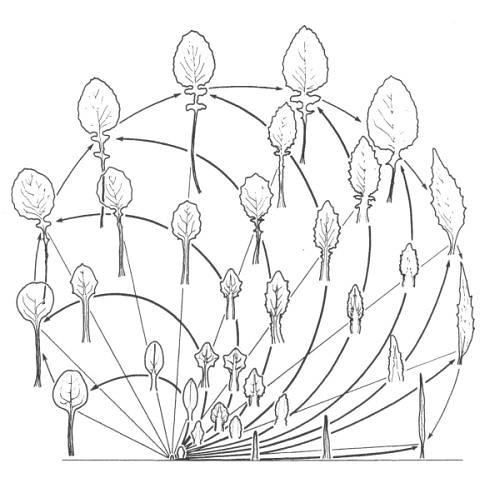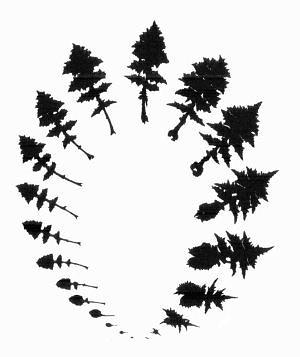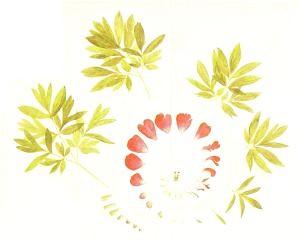
If you wish to understand yourself,
seek yourself in the wideness of the world;
if you wish to understand the world,
seek in the depths of your own mind.
Rudolf Steiner
Metamorphosis
Metamorphosis is a phenomenon whereby organisms changes shape or whereby components of an organism that occur in series, such as leaves on a plant or the vertebrae in a human body, change shape. It occurs in plants, animals and humans. Familiar examples include the metamorphosis of a tadpole into a frog and of a caterpillar via a pupa into a butterfly. Below, we discuss some examples in plants. You can find further examples in Bockemühl (1980) and Suchantke (2002).
Metamorfosis of plant leaves
Many plants have leaves that are all slightly different. If you remove the leaves of one plant and compare them, a pattern of change emerges, which is similar for all plants.

Leaf metamorphosis in poppy (from Bockemühl, 1990)
a. leaves arranged in random order
b. leaves arranged in logical order
c. leaves as they were arranged on the plant
This leaf series shows that during the growth stage, the leaves elongate and at the same time expand in all directions. The leaf mass spreads outward. This is followed by the segmentation stage: the leaf becomes ever more deeply incised, in a process that starts from the outer margin. Acute shapes appear while round shapes disappear. In the next stage, the process is reversed: the leaves become smaller again and the leaf mass withdraws into the stalk. This is the contraction stage, in which the leaf base becomes wider and more acute. This is called narrowing. We thus see a process involving four movements: elongation, expansion, segmentation and narrowing.
The plant produces a series of different leaf shapes. Although you don't see the transitions between the leaf shapes, you can create a mental picture of them them and thus re-create the continuous process of leaf metamorphosis.
If you look at the movement represented by an individual leaf, however, you can see the reverse process, starting with narrowing, then segmentation, then expansion and finally elongation.

Leaf development in nipplewort (from Bockemühl, 1980)
In the figure of the leaves of the nipplewort two opposite movements are combined. The outer circle shows the fully grown leaves, while the inner circle shows immature leaves. The arrows running left and right from the centre indicate the growth movement of the leaves. The bottom left part of the outer circle shows the first leaf to be formed, followed by the next leaves. The final leaf that is formed, just before flowering starts, is shown in the bottom right part of the outer circle. The thinner straight lines connect corresponding stages of fully grown and immature leaves, which do not represent the same leaf.
There is not only a metamorphosis in the leaves themselves, but also one from leaves to sepals, petals and anthers.

Lef development of the milk-thistle

Metamorfosis of the leaves and the petals of the peony
Exercises
General
Remove the leaves from a plant and place them side by side in an order that you feel is logical. Try to identify the stages of metamorphosis. Describe the stages as they occur in this plant. Write an imaginative and empathic description of what you see and of the developments and movements.
Movement of a development
Observe the leaves of a plant. Try to imagine that you're the first leaf, or the first stage. As a leaf, you can image your legs to represent the thin petiole, your trunk as the flat, wide leaf blade, and your head as the leaf tip. Now change yourself into the next leaf and observe the resulting change in your perception, experience or feeling. Now change into the next leaf, etc.
When describing this, you're actually capturing something that can't really be captured, as it involves an inner movement, a movement in terms of feelings. Use expressive imagery in your description.
Illustrations from books by Bockemühl.
